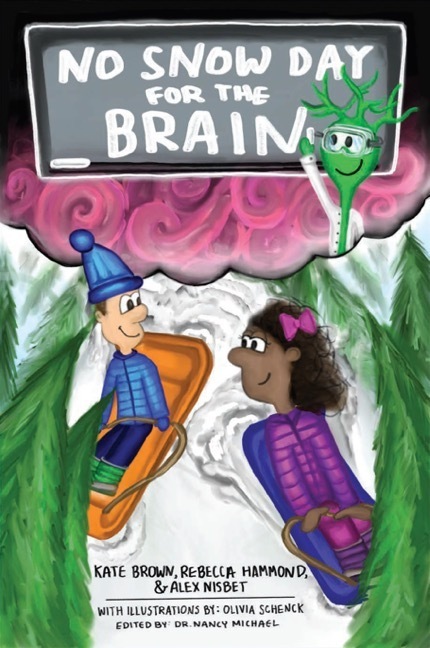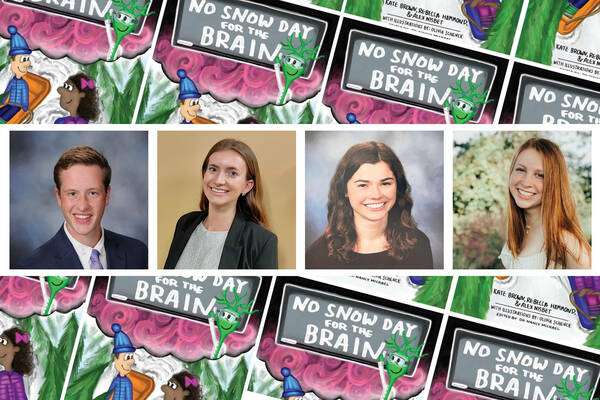Members of Notre Dame Neuroscience and Behavior major can add a new accolade to their program’s successes: published authors with their recent chapter book for children, No Snow Day for the Brain.
Professor Nancy Michael, Rev. John A. Zahm, C.S.C., Associate Teaching Professor, edited the story for three Notre Dame senior authors from her Fall 2020 Developmental Neuroscience course: Alex Nisbet, Kate Brown, and Rebecca Hammond (all ’21).
The idea sprang from one of the goals of the class, which is to teach students in a community-based learning setting how to convey scientific literature to a lay audience. This group of students worked with United Way of St. Joseph County and created a lesson plan with digestible information for primary caregivers on brain health.
Through their previous activities, the group of three joked that they could write a whole children’s story from the lessons and anecdotes they created. Velshonna Luckey, the Self-Healing Communities Director of Engagement, encouraged them to actually do so last spring. Through funding to support interns for the initiative, No Snow Day for the Brain was born.

“She’s the visionary dreamer,” Michael said of Luckey.
A children’s book is a unique way to share neuroscience with new communities, allowing them to “meet people where they are with tangible lessons on how science can foster healthy communities, empower relationships, and support the development of our youth,” Nisbet said.
The story contains two parts. The first is a chapter book of about thirty pages, featuring a pair of siblings on a snow day, with a cast of neuron characters to explain what’s going on in their brains through the ups and downs of their day off. While this part of the book is intentionally targeted to those who read at roughly a second grade reading level, it's a universal way to introduce any reader to ideas captured in neuroscience. The second half of the book builds on ideas introduced in the story, and offers more detailed neuroscientific information for parents and caregivers.
“The goal of the book is really to make neuroscience more accessible, and make neuroscience a usable tool for people to live healthier lives by understanding what the brain expects from the environment, and doing what we can to better meet those expectations,” Michael said.
As science students, the authors quickly had to learn to tap into their creative potential. With Luckey’s help, the authors embraced the challenge of starting an original project from scratch.
“I have been working with ND students for 20 years and I've learned that perfectionism can often get in the way when it comes to working with a community partner,” Luckey explained. “It's a delicate process to push humans beyond what they see in themselves… all of us have to be willing to take the risk together.”
Everything the authors did for this project was new for them or Self-Healing Communities.
“Even though there were times where I felt like I had no idea what I was doing, Velshonna always believed in me that I could find my creative stride and create a truly special work,” Nisbet said.
While former students wrote the story, a current neuroscience student answered the open call to serve as the illustrator at the start of this academic year. Olivia Schenck ‘25 wanted to take part, but at first was unsure if she could contribute without having yet taken the core neuroscience courses or having any professional art experience.
But she took on the challenge anyway.“I was learning to navigate a digital art platform for the first time while simultaneously learning neuroscience material,” she said.
“It was incredible how she was able to make our neuroscience ideas come to life through her drawings,” Brown said of Schenck. “What’s even more amazing is that she is a first-year student and hasn’t taken the core neuroscience courses yet, but by doing some outside research on the topics and using our sketches as a guide, she was able to create these incredibly detailed and engaging drawings!”
Schenck enjoyed the contributions she brought to the book. Her mother, an elementary school educator, brought to her attention the lack of representation of biracial families in classroom resources. Because of this, Schenck sought to include that representation in her illustrations.
“My favorite part of being the illustrator was being able to add details the storyline does not write about,” she said. “I sought to increase representation in conjunction to fulfilling the book’s original aims: fostering resilience, cultivating Self-Healing Communities, and educating our youth and community on our brains.”
The team was thrilled when their story was finally completed and published. “It was a long road to getting the book published and I am grateful for all the support and feedback we received,” Hammond said.
Nisbet expressed disbelief at their ultimate success: “Being a part of a book’s writing was never something I thought I would accomplish… it was amazing to reflect on all of the work Kate and Rebecca had done and how we all came together to complete this project.”
Michael expects that the book will be used in a variety of settings, from homes to doctor’s offices. Schenck had the opportunity to return to her grade school to present the story recently, as the creators hope that the book can be used in classrooms everywhere. “We heard from a therapist that she used the drawings in the story to teach kids about how emotions start in the body,” Brown said. “We also heard from a teacher who said the kids in her class have loved reading this book and talking about the brain!”

More than the personal enjoyment of the project, the authors hope that the story will have a lasting impact.
“I hope that writing this story gives anyone who reads, child or adult, an appreciation for the complexity of the brain and an understanding of how malleable the brain is,” said Hammond. “There is so much we can do to foster healthy, strong brains and bodies through relationships and communities.”